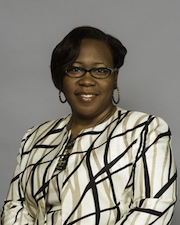Questioning the Calculations |
College Promise Programs | Donate! 


What's AHEAD: Commentary [Poll 2]
To join the discussion on these commentaries, please visit our Facebook page: http://www.facebook.com/PennAHEAD
Accountability and the Obama College Scorecard
We invited Penn AHEAD’s Bob Zemsky, and three Penn alumni, DeAngela Burns-Wallace, José Antonio Guzmán, and Philip Rogers, all leading scholar-practitioners, to comment on accountability and the What’s AHEAD survey results.
A Puzzling Disconnect
 Robert Zemsky
Robert Zemsky
Senior Scholar
Alliance for Higher Education and Democracy (AHEAD)
It has become a common blog headline, though in my memory it remains a classic rejoinder supplied by Lucille Ball, eyes wide open and mouth puckered-up in mock surprise: “They said what?” The implication was always that what wasn’t being said was more important than whatever pronouncement Lucy was responding to. And that pretty well sums up my reaction to the What’s AHEAD poll focusing on the Obama College Scorecard.
Despite a near torrent of media coverage reprising the lamentations of college and university presidents that the proposed rating system was misleading, mistaken, or just plain wrong, the subject of a rating system for higher education has little traction among those who manage basic administrative functions on the nation’s college campuses. True, there is more discussion of accountability; and true, the federal government is viewed as a major source of accountability demands, ranking second only to the demands of accrediting and other regulatory agencies. But the overall impression I gather from the poll’s results is that, at best, the President’s efforts are being viewed as just more “jaw-boning.”
Almost half of the respondents thought the Obama College Scorecard would have no demonstrable impact. While two thirds of those responding agreed that the measures currently being collected by accrediting agencies do not provide sufficient indicators of institutional quality, there is little if any confidence that what the President has proposed will make much of a difference. Perhaps, rather than Lucille Ball’s mock surprise, the What’s AHEAD poll results, and the responses of higher education leaders to the President’s proposal, ought to remind us of MAD magazine’s Alfred E. Neuman and his signature declaration, “What, me worry?”
The Diminishing Value Proposition of Higher Education—Affordability, Cost, and Accountability
 DeAngela Burns-Wallace
DeAngela Burns-Wallace
Assistant Vice Provost for Undergraduate Studies
University of Missouri
Higher education faces continuous scrutiny and calls for accountability around return on investment, value and quality of the education, and outcomes on two levels—learning and completion. Woven into this conversation is one of affordability and the rising cost of higher education. Various entities are questioning if the costs of higher education truly match the results.
The conversation has two loosely coupled strands: the first being the value proposition of what higher education adds to individuals and society, and the second being the responsibility of providing affordable and accessible education to society. It is not just parents and students questioning cost, but state legislators, the federal government, and the general public. This intersection of accountability and affordability is an important one that cannot be dismissed.
Some would argue that across higher education, we have not told our story very well, and it is now affecting our ability to show our value not only to our students but to society in general. For years, traditional higher education institutions have taken for granted that society understands the good work we do and the overall value we add. However, it is unclear if there is still a widespread belief that higher education is the engine for social mobility in our society. We have to be diligent about continuing to discuss and examine the cost in relation to quality and outcomes in higher education.
Overall, the accountability discussion affords higher education leaders the opportunity to ask questions like, where does higher education need to be in the next 10 years (as a whole and on an institutional level), and what has to change for that to happen. The answer to these questions in relation to affordability, and cost in particular, will require different conversations, new partnerships, innovation, and, some would say, courageous leadership.
Accountability in Chilean Higher Education
 José Antonio Guzmán
José Antonio Guzmán
President
Universidad de los Andes, Chile
There is now a strong disagreement in Chile between the “view on the street” and the opinion of experts regarding the situation of the higher education system. The public thinks that the system provides poor quality education and that the strong socioeconomic stratification in colleges perpetuates inequalities in society. Conversely, many education policy experts think the system works reasonably well; no one disputes that improvements are needed in access, quality assurance, and strategies aimed at promoting social integration, but insiders do not believe the system has to be “demolished.”
Among the many causes of this divergence, the main one is most probably the lack of accountability. Students, especially those from lower socioeconomic statuses, experience the high cost of education and the large amount of debt they owe, and yet do not benefit from the expenditure of so much time and money. Social pressure has been increasing and the new Government has been compelled to put forward radical reforms, which rely on the capacity of the public system to deliver the “better education” requested by the people.
The problem is not the poor quality of private universities, as some would like us to believe, but the lack of accountability in the system. Students and their families do not receive adequate information about the costs of education, compliance with quality indicators, graduation rates, employability of graduates, or use of public funds. In other words, the system’s stakeholders no longer tolerate throwing their money into “a big black box.” The first duty of the Government is to ensure that information is available and that flaws are corrected.
The great lesson offered by the current Chilean crisis is that countries must act in a timely manner to create effective accountability strategies. Higher education is a precious public good that costs the Government a great amount of money—and citizens will not tolerate squandering it.
Diverse Campuses, Diverse Approaches to Transparency
 Philip G. Rogers
Philip G. Rogers
Vice President and Chief of Staff
Office of the President, American Council on Education
One of the core strengths of the American higher education system is the collective diversity among the nation’s more than 4,000 colleges and universities. Each institution – regardless of sector or size – has its own distinct and specific mission. As a result of the rich diversity of our institutions, it is important to consider the merits of multiple state, association and institutional accountability strategies when assessing the value and performance of colleges and universities.
Discussions about the quality of higher education inevitably turn to the concept of public accountability as an increasingly significant way to demonstrate the worth and effectiveness of an institution. In many cases, the best strategies for ensuring such accountability involve transparent approaches to providing accurate data for consumers and the public.
Public and private institutions alike have developed exceptional accountability systems to demonstrate their worth to the public and policymakers. The University of Wisconsin System since 1995 has released comprehensive data-based reports focusing on key areas related to the academic, operational, and economic aspects of its constituent campuses. Similarly, in the private sector, New York University developed its annual “Life Beyond the Square” report that addresses issues such as student employment, earnings, and graduate school acceptance. Multiple national higher education associations have also engaged in valuable efforts to widely share other important metrics. The University and College Accountability Network, the Voluntary System of Accountability, the Voluntary Framework of Accountability, and the Student Achievement Measure represent many of the association-based strategies currently in use.
The American higher education system is fortunate to have access to a broad spectrum of accountability systems; however, no single approach will work effectively for all of our nation’s colleges and universities. Like many aspects of the higher education landscape, accountability is a case where “one size does not fit all.”



